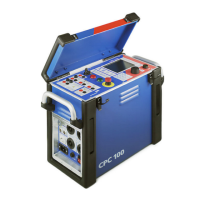CPC Getting Started
8 OMICRON
► Comply with the workflows described in this document. Avoid interruptions or distractions that could
affect safety.
► Do not insert objects (for example, screwdrivers, etc.) into any input/output socket.
► Use dry and clean cables and connectors.
► Do not connect any cable to the test object without a visible grounding of the test object.
► Do not remove any cables from CPC 100 or the test object during a test.
► Always lock connectors properly.
Before performing tests using high voltage, observe the following instructions:
► Do not operate the CPC under ambient conditions that exceed the temperature and humidity limits
specified in the respective user manual.
► Only use the CPC on dry, solid ground.
► Do not operate the CPC in the presence of explosives, gas or vapors.
► Unwind extension cables from their reel. Otherwise they will overheat.
► At their output sockets and especially in the cables connected to them, in operation the high-current
400A DC and 800A AC outputs generate a significant amount of heat (approx. 300 W/m at 800 A).
► After operation, wait for cables and clamps to cool down before touching them. If in doubt, wear
gloves.
► Never use the test cards Quick and Resistance to measure the resistance of windings with a high
inductance because turning off the DC source results in life-threatening voltage levels. For this kind
of measurement only use the special winding resistance test card RWinding, TRTapCheck or OLTC-
Scan.
► If you do not use the high-current outputs 400A DC or 800A AC, or the high-voltage output 2kV AC,
disconnect any cable that may be plugged into these sockets.
► Before disconnecting a device under test from the CPC, ground all terminals.
1.5 DC output to test objects with a high inductance
► Only use the dedicated test cards or tests in Primary Test Manager for DC measurements on assets
with inductive characteristics.
► Never open the measuring circuit while current flows.
► After a measurement, wait until the test device has discharged completely.
► Ground all terminals of the test object before touching the test setup.
► Short-circuit the terminals before disconnecting the test leads.
► Disconnect cables not used for testing both from the test object and the test device.

